Hiyashi chuuka: Japanese Chinese-style cold noodles
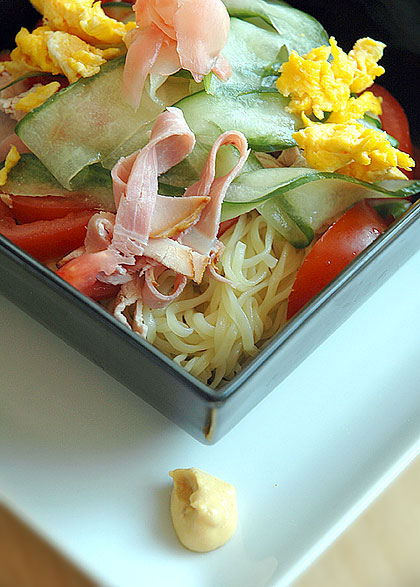
Summer in most parts of Japan is hot and very humid, so cold foods are very popular. There are a lot of cold noodle dishes, such as chilled soba noodles and thin wheat noodes (hiyamugi or so-men). I love them all, but I think my favorite is hiyashi chuuka, which is Chinese-style cold noodles as interpreted by the Japanese.
Hiyashi chuuka is a one-dish meal. The cold noodles are served with a variety of vegetables and meat on top. You can really use anything, as long as it tastes good cold. Here I've used cucumber ribbons, some roast ham and pork slices thinly cut, and tomato. There's a bit of scrambled egg and some pickled sushi ginger too (since I was out of the brightly red beni sho-ga.) The key to bringing it all together is the slightly vinegary, sesame-rich dressing or gomadare. It's really a sort of pasta salad. Noodle shops in Japan don't serve hiyashi chuuka during the rest of the year, so the signs announcing "Now serving hiyashi chuuka" signal that summer has arrived.
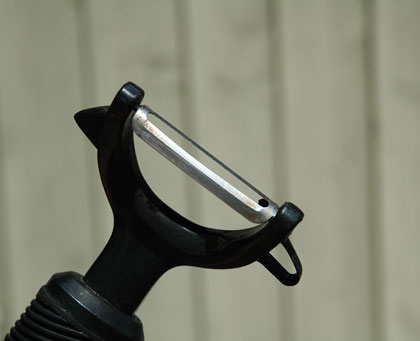 Let me touch on cucumber ribbons. They seem like a really fancy thing, but are very easy if you use a vegetable peeler, and look like you spent a lot of time and effort.
I can't use the vertical kind of peeler at all, being left handed, but with a horizontal type peeler like the one pictured here, all I do is to take long, thin slices off a regular English-type cucumber (the kind that comes shrink-wrapped in plastic from the Netherlands), turning the thing as I peel, until I end up with the inner core of mostly seeds, which I just throw away.
Let me touch on cucumber ribbons. They seem like a really fancy thing, but are very easy if you use a vegetable peeler, and look like you spent a lot of time and effort.
I can't use the vertical kind of peeler at all, being left handed, but with a horizontal type peeler like the one pictured here, all I do is to take long, thin slices off a regular English-type cucumber (the kind that comes shrink-wrapped in plastic from the Netherlands), turning the thing as I peel, until I end up with the inner core of mostly seeds, which I just throw away.
Now, about the cold noodles. Unlike Western style cold pasta dishes, where the noodles are meant to be cooled naturally, in Japanese cooking the noodles are rinsed repeatedly in cold water, to both cool them off and to get rid of any surface starch. If you're Italian the thought of rinsing noodles may make you shudder, but it's critical here. Here is a pudgy little hand washing the noodles under cold running water.
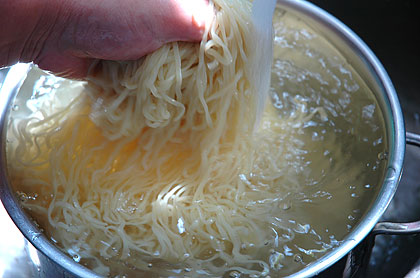
You actually scrub (gently, so you don't break the noodles) the strands under running water, until you don't feel any sort of stickiness on the surface. Once the noodles reach this state, you drain them thoroughly before proceeding. This washing stage is critical to making good Japanese (or Japanese-style Chinese) cold noodles.
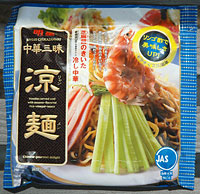 For the noodles, try to find thin, flat egg noodles at an Asian food store. Thin linguine can be a substitute, though it will have a very different texture from the Asian noodles. Remember to salt the water well if you go with that: Italian pasta doesn't have salt in it but Asian noodles usually do. If you can't be bothered with making the sauce and things and live near a Japanese market, the Chuukazanmi brand of instant hiyashi chuuka pictured here is very good, and comes with little packs of delicious readymade sauce. You do still have to rinse the noodles.
For the noodles, try to find thin, flat egg noodles at an Asian food store. Thin linguine can be a substitute, though it will have a very different texture from the Asian noodles. Remember to salt the water well if you go with that: Italian pasta doesn't have salt in it but Asian noodles usually do. If you can't be bothered with making the sauce and things and live near a Japanese market, the Chuukazanmi brand of instant hiyashi chuuka pictured here is very good, and comes with little packs of delicious readymade sauce. You do still have to rinse the noodles.
Hiyashi-chuuka with gomadare (sesame sauce)
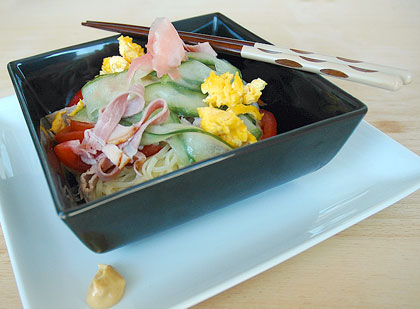
For about 4 main course sized servings:
- 1 Tbs. rice vinegar or cider vinegar
- 1 Tbs. soy sauce
- 1 tsp. sugar
- 2 Tbs. water, or chicken stock, or dashi stock (water with soup granules is fine here)
- 2 Tbs raw sesame seeds, or 1 Tbs tahini
- 2 tsp. dark sesame oil
- 1 Tbs. dry mustard powder reconstituted with enough water to make a paste
- 300g / 10 oz. dried Chinese egg noodles, or hiyashi chuuka noodles, or thin linguine
- 1 cucumber, cut into ribbons (see above)
- 2 cups or so of thinly cut roast ham, or roast pork, or cooked chicken
- 2 small tomatoes, de-seeded and cut into thin wedges
- Optional: 1 scrambled egg
- Optional: some pickled sushi ginger (gari) or bright red pickled shredded ginger (beni sho-ga)
To make the sauce: If you're using sesame seeds, toast them in a small pan until they start to pop. Remove from the heat immediately. In a mortar and pestle or a spice grinder, grind up the sesame roughly. Combine the sesame seeds or tahini, vinegar, soy sauce, sugar, water or stock, and sesame oil and mix well. Taste and adjust the amount of soy sauce, sugar or vinegar if needed. (You can make this spicy at this point by adding some crushed red pepper flakes.)
In the meantime, heat up a large pot of water to boil. If using linguine, put salt in the boiling water. Cook the noodles of your choice in the water just until it's al dente. The cooking time will vary according to what kind of noodles you're using. Do not cook until the noodles are mushy.
Drain the noodles, then put them back in the pot. Fill the pot with cold running water, and rinse the noodles well (see above technique) until there's no starchiness to them. Drain well.
To serve, put a mound of noodles on each plate - plates with rims, or soup dishes, are ideal here. Arrange the vegetables, meat, egg and ginger attractively on top. Pour over the sauce. Serve a small dollop of the mustard on the side of the plate.
To eat, mix the noodles well, adding a bit of the mustard if desired.
If you enjoyed this article, please consider becoming my patron via Patreon. ^_^

 Welcome to Just Hungry, where we serve authentic Japanese recipes and more! I'm
Welcome to Just Hungry, where we serve authentic Japanese recipes and more! I'm 












Comments
Jill H.
6 July, 2006 - 08:10
Permalink
Hiyashi chuuka: Japanese Chinese-style cold noodles
This looks so yummy! My dad always would make this during the summertime, but he grew up more in hawaii than japan, so we have things like Spam on it.
Barbara
11 July, 2006 - 21:02
Permalink
Hiyashi chuuka: Japanese Chinese-style cold noodles
This looks delicious. I am definitely going to try it next week. This is the first time I've been to your site and I love it!
Pam
17 July, 2006 - 03:53
Permalink
Hiyashi chuuka: Japanese Chinese-style cold noodles
thank you so much for this recipe! when i lived in niigata-ken about ten years ago, this was one of my favorite summertime foods. i just bought some really nice japanese cucumbers at the farmer's market, and decided to try making cold noodles
sarah
8 July, 2008 - 19:52
Permalink
mmmm...
Thanks for posting this recipe!
I just finished a delicious lunch of cold hiya mugi, which I bought by mistake thinking it was somen. What a surprise! I love somen, but I enjoyed these thicker noodles as well. I wonder if they would work with the Chinese style application? Will try and see...
anon.
26 June, 2010 - 14:39
Permalink
Re: Hiyashi chuuka: Japanese Chinese-style cold noodles
Thank you for this recipe. I visit this site every year around summer to check this one up!